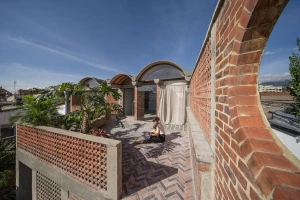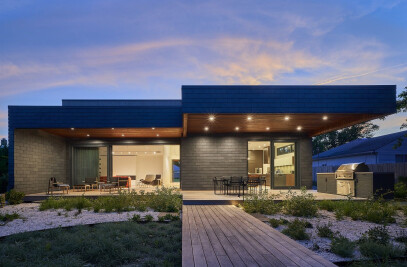Looking out to the Great Smoky Mountains of Tennessee, the Short Mountain House by Sanders Pace Architecture is divided into three distinct pavilions. This strategy allows space to be efficiently compartmentalized to meet the needs of the owner or expanded into adjacent pavilion areas when extra space is required for guests.

The pavilions are oriented in a way that defines a unique series of negative/exterior spaces around the house and allows for clear sightlines into the surrounding landscape. Connectors designed as bridges span the space between the pavilions, linking them together.

Though the simple gable roofs are in keeping with the region’s vernacular, the roof pitches are based on proportions and forms found in Japanese architecture. In line with a restrained Japanese aesthetic, the exterior materials of stone veneer, wood siding and standing seam metal help harmonize and blend with the surroundings.

Two different types of wood siding were used for the pavilion exteriors. The first is an Accoya brushed with a shou sugi ban finish. This traditional Japanese treatment process helps to preserve wood by charring it. The result is a dark board that is also resistant to rot, insects and decay.

The second wood siding is used in inset ‘engawa’ spaces. A feature of traditional Japanese architecture, the engawa is a covered strip of decking, often finished in wood, which runs the periphery of the house and acts as a transition between house and garden.

Marking the transition from indoors to outdoors, each pavilion includes and individual engawa space along with a covered porch, which helps to control solar heat gain.































